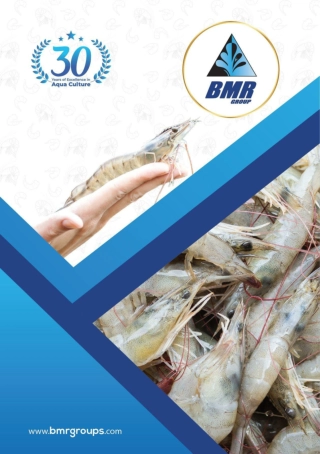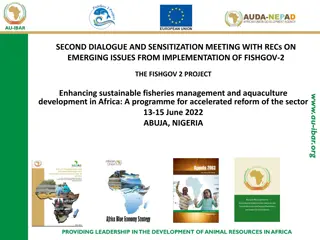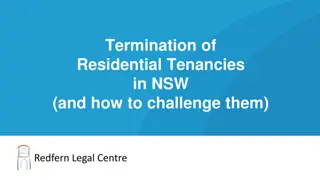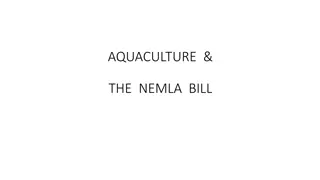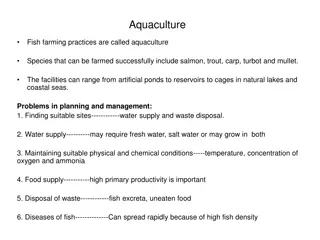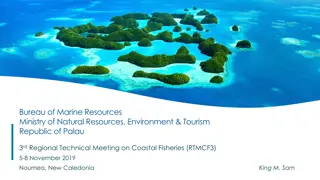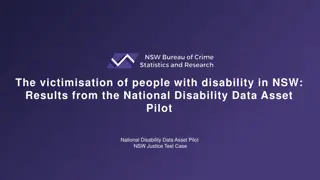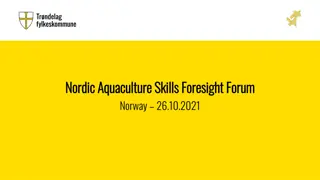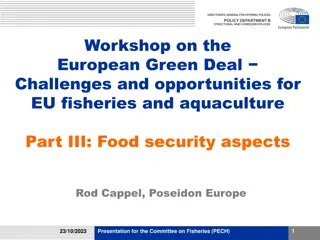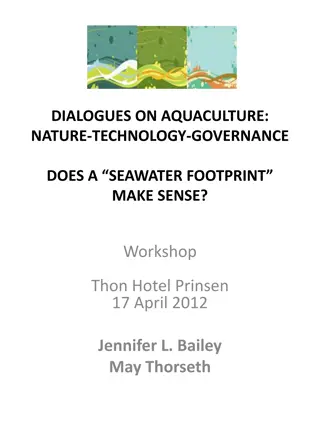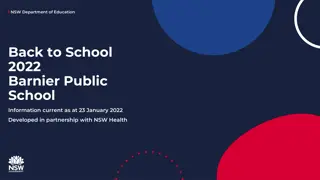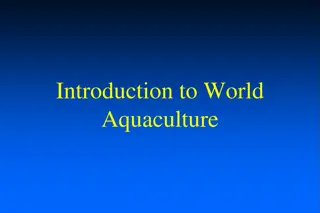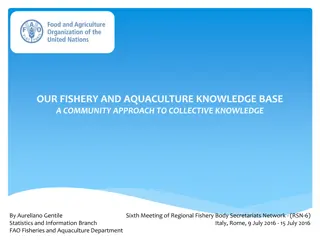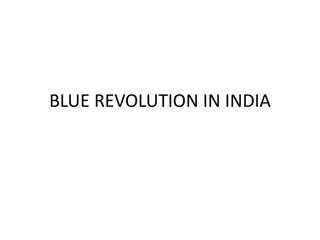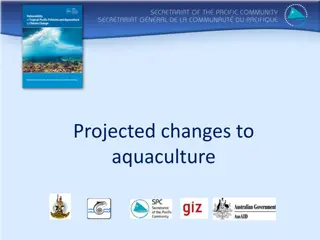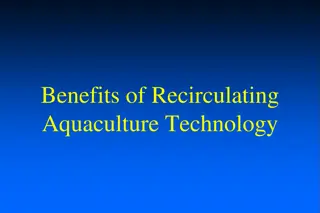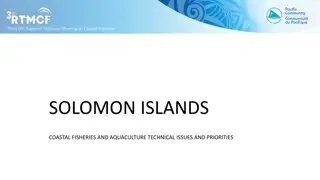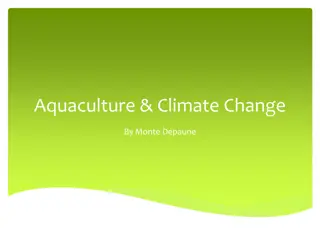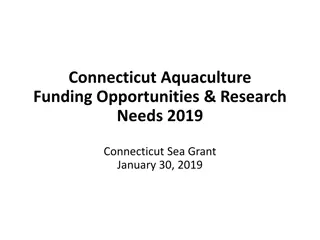NSW Aquaculture Research Advisory Committee RD&E Strategic Plan 2024-2029
The NSW Aquaculture Research Advisory Committee (ARAC) was established to advise the Minister on contributions for aquaculture research and development. The strategic plan outlines priorities, framework, and performance indicators for RD&E investments in the NSW aquaculture industry. It emphasizes collaboration among industry sectors, research organizations, and government agencies to support sustainable and profitable aquaculture industries. The plan also includes enabling priorities to enhance industry resilience and participation in RD&E activities.
Download Presentation

Please find below an Image/Link to download the presentation.
The content on the website is provided AS IS for your information and personal use only. It may not be sold, licensed, or shared on other websites without obtaining consent from the author.If you encounter any issues during the download, it is possible that the publisher has removed the file from their server.
You are allowed to download the files provided on this website for personal or commercial use, subject to the condition that they are used lawfully. All files are the property of their respective owners.
The content on the website is provided AS IS for your information and personal use only. It may not be sold, licensed, or shared on other websites without obtaining consent from the author.
E N D
Presentation Transcript
1 NSW Aquaculture Research Advisory Committee RD&E Strategic Plan 2024-2029
NSW Aquaculture Research Advisory Committee (ARAC) 2 ARAC was established in October 2006. ARAC is a statutory committee that advises the NSW Minister on the amount of contributions payable by the NSW aquaculture sectors into trust accounts for aquaculture research, development and extension (RD&E) and the expenditure of those trust funds. ARAC shares the NSW DPI vision: Innovative primary industries in strong regional communities Innovative research supporting profitable, resilient, sustainable aquaculture industries and their communities to increase farmgate value to $300 million by 2030 About this Plan This plan provides guidance for the development and implementation of RD&E in support of the NSW aquaculture industry. This RD&E plan was developed at an ARAC workshop on the 23rdNovember 2022 taking into account: advice from aquaculture permit holders and other stakeholders, NSW DPI staff and Dr Geoff Allan; the need for evidence based aquaculture policy development in NSW; Department of Primary Industries, Stronger Primary Industries Strategy 2022-2030 National Aquaculture Strategy 2017-27; Fisheries Research and Development Corporation RD&E Plan 2020-25; Australian Murray Cod Strategic RD&E Plan 2022-2027; other relevant plans or RD&E reviews; and completed, current and planned RD&E and related activities At the workshop a number of topics were raised that did not require the creation of new knowledge, processes or technology but rather the extension of same to end-users. These topics have been included under the Adoption program. Highlighted in the plan are the RD&E priorities for each aquaculture sector. The plan will be used collaboratively by industry sectors and enterprises, research organisations, relevant government agencies andothers working in support of the aquaculture industry. The plan recognises the competitive advantages held by NSW. ARAC will review the plan each year (latest revision Nov 2022). Copies of this plan are available from NSW DPI, Port Stephens Fisheries Institute, email: rachel.kerma@dpi.nsw.gov.au or the website www.dpi.nsw.gov.au. During the consultative and development processes a number of priorities were identified that were not RD&E by nature, but ratherrelated to activities that would nevertheless enhance the resilience and performance of the aquaculture industry, and importantly, better enable it to participate in the planning and execution of RD&E and the adoption of results. These enabling priorities have, therefore, been included in this plan. NSW Aquaculture Research Advisory Committee, RD&E Strategic Plan 2024-2029
3 Plan framework The framework is based on the input output - outcome model of investment. In this context: Inputs are the resources in the form of people, expertise, materials, energy, facilities and funds that research organisations and their partners use in activities to produce outputs. Outputs are the goods and services mainly knowledge, processes and technology that research organisations and their partners produce for end-users. Outcomes are the results, impacts or consequences flowing from the adoption of outputs by end-uses. RD&E investment performance The ability to measure RD&E investment performance depends on the quantity and quality of available data. Further, it depends on the nature of the activity. For example, the performance of an activity with a strong public good component would be more difficult to measure (usually qualitative) than one with a strong private benefit component (usually quantitative). The key performance indicators (KPI) described below are a guide only to how performance could be measured. Ideally, such indicators with targets should be detailed in individual projects. As indicted in the program framework below, the balance between the public good and private benefit components of RD&E varies between programs and priorities. As a general rule public good RD&E attracts a higher government investment than private benefit. Therefore, for RD&E with strong private benefit components to attract government investment, there needs to be evidence of market, institutional, technical, policy or political failure. NSW competitive advantages NSW is well placed to further develop an aquaculture industry that is domestically and internationally competitive. Its competitive advantages are: a subtropical-temperate climate that enables the selection from a wide range of species those that can compete in the marketplace; world class research capabilities including those that can be drawn from other states and territories and from overseas; Australia s highest seafood consumption that enables near-to-market production; coastal infrastructure to support aquaculture; a Government policy platform that supports the sustainable development of aquaculture; and the foremost Australian state for seafood sales and transport infrastructure. NSW Aquaculture Research Advisory Committee, RD&E Strategic Plan 2024-2029
4 Primary Production Program outcome: Substantial increase in the sustainable production and value of selected aquaculture species. Sectoral Priorities(Add separate column for algae) FreshwaterFinfish (MurrayCod,Silver Perch and salmonids) Outputs Molluscs MarineFinfish (YellowtailKingfish and Mulloway) Other Algae - emerging Knowledge, processes and technology relating to: (edible oysters, mussels, pearls, clams, abalone) crustaceans, echinoderms, polychaetes, 1. Increase utilisation and protection of existing sites 2. Facilitate access and development of suitable sites (land and marine sites) 3. Integrate with other emerging industries 4. New Project Proposal for marine site identification 5. Assist Blue Economy Working Group 1. Develop innovative productionand system technology 2. Reduce production input costs 3. Integrate production and management tools with compliance and monitoring 4. Optimise energy efficiency and security through new technology 5. Optimise technology for conservation aquaculture 1. Develop lease and estuary management tools. 2. Improve grading technology i.e Artificial Intelligence (AI) 3. Develop understanding of local environments to enable site specific growing techniques 4. Promote concept trials of improved stock. Increase hatchery and nursery capacity, reliability and efficiency Improve breeding technology development Improve genetics for disease resistance, faster growth, marketability, climate resilience and other traits Improve broodstock feed Aquaculture sites Production efficiency 1. Optimisecarrying capacities 2. Develop land based systems 1. Optimise production and feed 1. Improving hatchery and production technology 2. Approvals for commonwealth waters 1. Optimise production systems 2. Improve husbandry and harvesting techniques Increasehatchery and nursery capacity, reliabilityand efficiency Seed/fingerling supply Breeding Support the development of genetics programs for disease resistance, faster growth, marketability, climate resilience and other traits 1. Improve cost-effective feeds 2. Develop appropriate feeds for emerging species 3. Develop sustainable feed ingredients Feed High priority NSW Aquaculture Research Advisory Committee, RD&E Strategic Plan 2024-2029
Sectoral Priorities 5 Outputs Molluscs Freshwater Finfish (Murray Cod, Silver Perch and salmonids) Marine Finfish (Yellowtail Kingfish and Mulloway) Other Algae Knowledge, processes and technology relating to: Biosecurity (edible oysters, mussels, pearls, clams, abalone) (crustaceans, echinoderms, polychaetes, Further develop stock movement protocols 1.Furtherdevelopstockmovementprotocols 2. Implementation of best practice biosecurity management plans both Algae - genetics, translocation and disease detection capacity Bivalve genetics and translocation Aquatic Animal Health Improvethemanagementof threatstoshellfishhealth includingWinterMortality, POMSand QX. Improveaquaticanimalhealthincidentreportingandfacilitateemergencypreparedness ImprovetheprocessforensuringAPVMAapprovalforaquaculturechemicals Improvethemanagementof threatstofinfish including nodavirusandmegalocytivirus Improvethe management of threatsto crustacea including white spot disease and APHND-like virus 1. Reduce adverse impacts of aquaculture on the environment 2. Mitigate adverse impacts of external influences (including climate change) on aquaculture 3. Further develop Environmental Management Systems for all sectors 4. Understanding environmental services of aquaculture and the environment 5. Promote circular economies for aquaculture 1. Improve water quality surveillance and facilitate use of that data 2. Identify and reduce the impacts of oyster farming on seagrassesand Posidonia Determine the quality of discharge water from production and recirculation aquaculture systems 1. Determine the environmental impacts of culture on surrounding environment 2. Determine the impacts of culture on other wild populations (sharks, etc) Environment High priority NSW Aquaculture Research Advisory Committee, RD&E Strategic Plan 2024-2029
5 RD&Eunder this programwould be expected to have a strong public good component. Investment target: 45 % Key performance indicators: Production. This relates to the level of increase in sustainable aquaculture production. Value. This relates to the level of increase in the gross value of aquaculture production. NSW Aquaculture Research Advisory Committee, RD&E Strategic Plan 2024-2029
6 Post-harvest and Market Development Program outcome: Increased demand and access to premium markets for Australian aquaculture seafood; fulfilment of consumer demands for safe, high-quality, nutritious seafood products; and increased profitability throughout the value chain. Sectoral Priorities Algae Outputs Molluscs (edible oysters, mussels, pearls, clams, abalone) Freshwater Finfish Marine Finfish Other Knowledge, processes and technology relating to: (crustaceans, echinoderms, polychaetes, 1. Develop market opportunities for low grade/value products 2. Develop uses for production and processing waste 3. Develop value added ready to use products that meet consumer demand 4. Wet storage systems -molluscs only 1. Improve consumer knowledge and expectations 2. Develop market opportunities 3. Achieve and maintaining market access for export 4. Benchmark knowledge of consumption and consumer satisfaction Develop a toolbox of oyster provenance marketing releasing notifiable disease into waterways Product development Market development Determine the implications of Retailer and food services sector knowledge and skills 1. Improve retailer and food services knowledge and skills 2. Improve retail wet storage facilities molluscs 1. Improveproducthandlingthroughoutthesupplychain 2. Minimise production disruptions 3. Improve supply chain processes and technology Supply chain High priority NSW Aquaculture Research Advisory Committee, RD&E Strategic Plan 2024-2029
7 RD&E under this program would be expected to have a strong private benefit component. Investment target: 20 % Key performance indicators: Consumption. This relates to the level of increase in consumption of aquaculture products. Consumer knowledge. This relates to the level of consumer knowledge of aquaculture products. Consumer satisfaction. This relates to the level of consumer satisfaction with aquaculture products. Market access. This relates to the level and effectiveness of access to domestic and international markets. Retailer knowledge. This relates to the level of retailer knowledge of aquaculture products. Profitability. This relates to the level of profitability throughout the value chain. NSW Aquaculture Research Advisory Committee, RD&E Strategic Plan 2024-2029
8 Communities Program outcome: The community is knowledgeable and supportive of the aquaculture industry, the natural resources on which it depends and its economic and social benefits to Australia. Sectoral Priorities Algae Outputs Molluscs (edible oysters, mussels, pearls, clams, abalone) Freshwater Finfish Marine Finfish Other Knowledge, processes and technology relating to: (crustaceans, echinoderms, polychaetes,) 1. Utilise the results of study on the social and economic benefits of aquaculture to NSW 2. Continue to build-on the evaluation of the social and economic benefits of aquaculture to NSW 3. Enhance techniques for regional community engagement initiatives 4. Inform the community about the stewardship role that the aquaculture industry plays in protecting the environment 5. Improve public perception of aquaculture farmed products 6. Improve ways to engage with local communities to increase their understanding of aquaculture 7. Education and greater awareness of the environmental services value of aquaculture (for example, nitrogen and phosphorus cycling, water usage, CO2footprint) 8. Use dollar values to reinforce the positive role that aquaculture species play in local ecology Inform the community of the positive role that restorative and regenerative aquaculture plays in local ecology(to replace oysters) Increasing community knowledge of the aquaculture industry and related natural resources Informthe communityofthe positive rolethat algae play in local ecology Community involvement in ways that will benefit the aquaculture industry and related natural resources Develop opportunities for the community to participate in a stewardship role with respect to the natural resources on which the industry depends NSW Aquaculture Research Advisory Committee, RD&E Strategic Plan 2024-2029
9 RD&E under this program would be expected to have a balance of public good and private benefit. Investment target: 15 % Key performance indicators: Community Support. This relates to the level and effectiveness of community support for the aquaculture industry and the natural resources on which it depends. Community Involvement. This relates to the level and effectiveness of community involvement in the aquaculture industry and in protecting and rehabilitating the natural resources on which it depends. Reducing community opposition to aquaculture developments NSW Aquaculture Research Advisory Committee, RD&E Strategic Plan 2024-2029
10 People Program outcome: The knowledge and skills of people in and supporting the aquaculture industry are developed and used to derive maximum economic, environmental, and social benefits for the industry and Australia. Sectoral Priorities Algae Outputs Molluscs (edible oysters, mussels, pearls, clams, abalone) 1.Identify and support potential leaders and promote training opportunities eg. the Seafood Industry Leadership Program and afford them opportunities to become members of industry related entities and participate in industry meetings, forums, etc 2. Encourage industry enterprises to undertake business management, media and other relevant training 3. Encourage succession planning within industry enterprises Freshwater Finfish Marine Finfish Other Knowledge, processes and technology relating to: (crustaceans, echinoderms, polychaetes, Leadership development among people in and supporting the aquaculture industry Vocational competence of people in and supporting the aquaculture industry 1. Encourage industry enterprises to ensure an appropriately trained and qualified workforce 2. Encourage industry people to attend relevant conferences and to undertake study tours 3. Develop and provide resources (e.g. online courses, Biosecurity, Standard Operating Procedures) for new entrants into the industry Encourage education institution interest in aquaculture and foster educational opportunities for industry participants Enhancing Academic Skills Communication Building capacity among industry and government to enhance community engagement. NSW Aquaculture Research Advisory Committee, RD&E Strategic Plan 2024-2029
11 RD&E under this program would be expected to have a balance of public good and private benefit. Investment target: 10 % Key performance indicators: People Development. This relates to the number and quality of people whose capabilities have been improved. People Advancement. This relates to the number of people who have succeeded in gaining leadership and other important positions in and supporting the aquaculture industry. NSW Aquaculture Research Advisory Committee, RD&E Strategic Plan 2024-2029
12 Adoption Program outcome: RD&E outputs are used in a way to derive maximum benefit from RD&E investment. Sectoral Priorities Outputs Molluscs (edible oysters, mussels, pearls, clams, abalone) Freshwater Finfish Marine Finfish Other Algae Knowledge, processes and technology relating to: (crustaceans, echinoderms, polychaetes) 1. Ensure adoption is a fundamental target for every aquaculture project 2. Provide advice on all relevant research outputs 3. Provide advice on where to obtain information on completed, current and planned RD&E 4. Provide advice on where to obtain advice of a non RD&E nature 5. Undertake field days (Q&A) for aquaculture 6. Develop a one-stop-shop for knowledge brokering Continue the role of the OceanWatch oyster industry extension officer Extension of RD&E outputs Facilitation of the adoption and (if appropriate) commercialisation of RD&E outputs Investigate the need for sectoral extension officers NSW Aquaculture Research Advisory Committee, RD&E Strategic Plan 2024-2029
13 RD&E under this program would be expected to have a balance of public good and private benefit. Investment target: 10 % Key performance indicators: Extension. This relates to the level and effectiveness of the extension of R&D outputs. Adoption. This relates to the level and effectiveness of influence over the adoption of R&D outputs. NSW Aquaculture Research Advisory Committee, RD&E Strategic Plan 2024-2029



